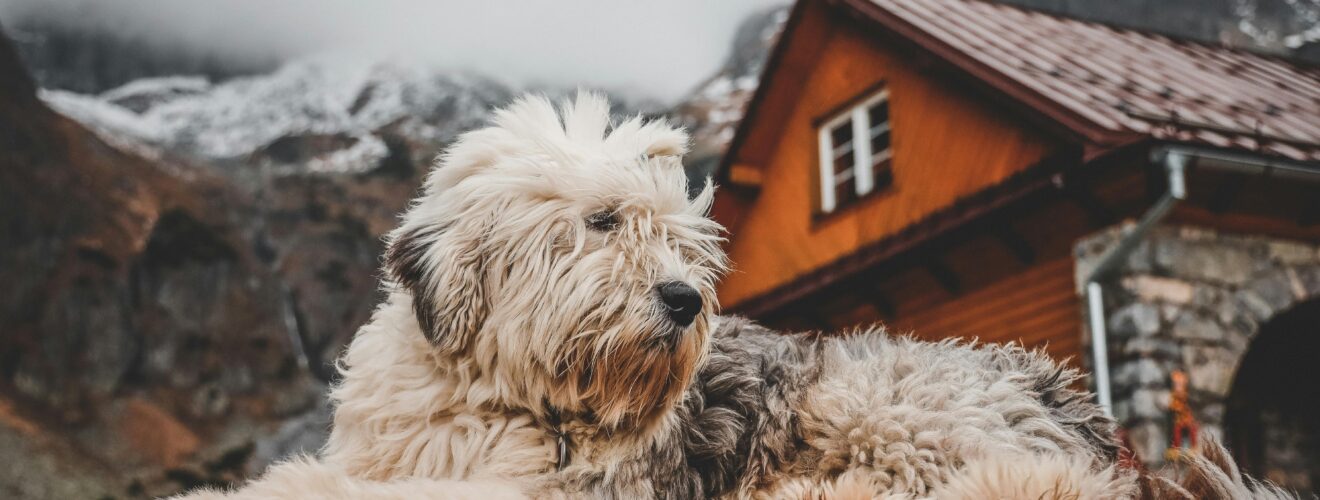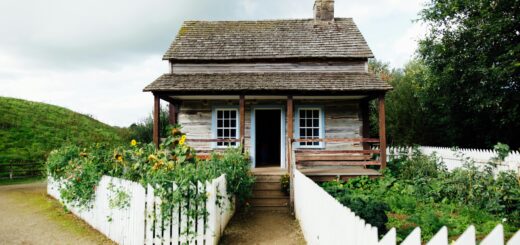How to Construct a Dog House

Provide your dog with a cozy dog house to relax that is protected from the sun, rain, and wind.
You probably think of your pet as a member of the family and enjoy the company of your dog on long walks, energetic games like fetch or frisbee, or just the constant companionship that comes with owning a dog. Not only can building a doghouse be a wonderful way to show your dog how much you care, but these outdoor buildings may shield your pet from the elements—such as strong winds, rain, and sun—when they’re out and about.
Note this before you slap together a crude structure out of some spare building supplies from around the house: An improperly constructed doghouse can seriously endanger your pet’s safety. In order to create a doghouse that is safe for your dog, be sure to buy new, dependable building materials and according to following instructions.
Arrange the Doghouse
You must create a thorough plan that includes measurements for the walls, roof, structure, and total size based on the size of your dog before attempting to build a doghouse. To ensure that your dog can utilize the doghouse long after they grow out of their puppy years, you should change the measurements if your dog is still growing.
A doghouse should normally be between six and one foot longer than your dog in length to provide them plenty of room to relax. In a similar vein, the doghouse’s width should be around 6 inches less than its length, and its height should match its length.
For instance, the doghouse should be 36 inches long if your dog is around 2 feet long. In addition, the doghouse’s height and breadth should measure 36 and 30 inches, respectively. To ensure that the dog has adequate room to enter and escape without difficulty, cut an aperture for the dog that is at least 6 inches above its height and 6 inches wider than the dog. The entrance should be at least 24 inches tall and 18 inches wide to accommodate a dog that is around 1½ feet tall and 1 foot broad.
To calculate the length of the 2x4s required to make the sloping A-frame, you will need to take many more measurements if you are building a doghouse with a gabled roof. Calculate the doghouse’s half-width and the height from the top of the wall to the roof’s apex. The doghouse in the above example would have a half-width of 15 inches and a peak height of around 6 inches from the top of the wall, however you could adjust the height to change the slope of the roof.
Utilizing the Pythagorean theorem (a² + b² = c²), determine the length of the A-frame’s slanted sides using these dimensions. The computation in the above example would be 15 + 6 = 16.2. This can be rounded up to 17 inches. It is a good idea to add around 1 inch to the length so that the roof goes out over the side of the wall to form an overhang.
You should also think about your doghouse’s needs for insulation, ventilation, and structural stability. Even while some designs call for 2x2s, a stronger 2×4 structure is what you should use to assist keep the doghouse from collapsing during inclement weather. In addition to the entrance at the front of the doghouse, ventilation may also be enhanced by adding apertures beneath the roof overhang and at the top of the walls. In order to increase winter comfort and minimize heat loss, insulation can be added to the roof, walls, and floor in colder areas.
To find out if you require a construction permission for the doghouse, consult the municipal rules. Although most towns and cities won’t require one, it’s best to double check in advance to see whether you need one for a tiny doghouse on your property. If you don’t, building the doghouse without a permission may result in fines or the need to have it torn down.
As you review the requirements, be sure to take note of any local legislation pertaining to the leaving of dogs outside. Although a dog house might provide a cozy place for a puppy to relax, it shouldn’t serve as your dog’s primary residence: The American Kennel Club notes that many localities have regulations controlling the conditions in which you’re permitted to leave your dog outside—and when you’re not—and PETA maintains that dogs shouldn’t be left outside in high heat or inclement weather. If you go longer than necessary with your dog outside, make sure you follow all rules and laws and treat your creature with compassion.
How to Construct a Dog House
To go along with your written concept, draw up a rough layout for the doghouse. This will make it easier for you to see the measurements when you’re creating. Give your plans some last thought before making any material purchases. Choose where to put the yard and if you want to have a slanted gable roof or a flat roof.
Items You’ll Require
- Two-by-fours
- plywood
- Saw
- tape measure
- Drill Bits
- Nails for roofing
- Shingles
- Paintbrush
- Tar paper
- Primer
- Paint
Step 1: Get the Wood, Screws, and Other Materials You’ll Need
When your layout is complete, you should know roughly what supplies you’ll need to buy, such as plywood, 2x4s, roofing nails, 3 and 1½-inch screws, and shingles. Depending on the size of the doghouse, different quantities of 2x4s, plywood sheets, screws, nails, and shingles will be needed for the project. To ascertain the precise measures required for constructing the doghouse, see the blueprint. When in doubt, it’s usually preferable to have extra than you require than to run out in the middle of the project.
Step 2: Measure, cut, and construct the base
You may begin working on the base of the dog house once you have established its size. Two long 2x4s that are the same length as the doghouse should be measured and cut. In addition, measure and cut three shorter 2x4s to the doghouse’s intended width. The base’s breadth will be formed by the short parts, and its length will be built by the long pieces.
Assume that the 2x4s are flat on a 2-inch side. Next, arrange them in a rectangular shape by lining up the two long and the two short pieces across from one another. To add stability, insert the last, shorter piece into the middle.
Using your drill, put two 3-inch screws into each of the four corners after butting the length pieces up to the width pieces. In order to fasten the piece of wood with two 3-inch screws at each end, drill through the middle of each length piece and into each end of the central width piece.
Step 3: Put in the Underfloor Insulation
Plywood will be used for the dog house floor. A piece of plywood should be measured and cut to fit over the base structure. If you are going to insulate the dog house, cut a piece of foam insulation board to fit in between the floor joists and use an outdoor glue that is resistant to weather to attach it to the plywood. Place the plywood insulation side down on the foundation, then fasten it using ½-inch screws.
Step 4: Put the Framework Together
The method then moves on to measuring, cutting, and constructing the dog house ‘s front, back, and sides. Four 2x4s that will be used as the dog house ‘s corner posts should be measured and cut. Measure the height of the walls using your blueprint, then cut these four 2x4s to match. Four more 2×4 pieces that fit the base’s measurements must also be cut.
To fasten the corner posts to the foundation, place them vertically in each of the four corners and drill two 3-inch screws into each one. Using the four leftover 2x4s that match the floor basis, construct the rectangular roof base. A third short piece that is identical to the support beam in the floor base can be cut and inserted in the center of the roof base if you are creating a doghouse with a flat roof.
If you are constructing a sloping gable roof, you will also need to measure and cut six more pieces for the central support that runs the length of the peak and the A-frame walls at either end of the roof. Make sure your measurements match the above Pythagorean theorem calculation, then cut two angled 2×4 pieces for the dog house ‘s front and rear. With the roof base acting as the triangle’s bottom, arrange the two front sections to form a triangle frame. Using 1½-inch screws, secure the pieces at the center and attach them to the roof foundation. For the doghouse’s rear, repeat these steps.
Two 2x4s should be measured and cut to length to span the roof peak. To create a triangular support beam, attach the two sections together by drilling 3-inch screws through the 4-inch side of one 2×4 and into the 2-inch side of the second 2×4. To create a triangular center support beam for the roof, place the support beam at the top between the two triangle frames. Two three-inch screws are used to fasten the support beam to the triangular frame on each end.
Step 5: Install a plywood roof and walls for Dog House
Once the frame is constructed, test its strength by putting weight, moving, and shaking on it. You may start fastening the plywood roof and walls if it holds up. For the doghouse’s sides, measure, cut, and attach two rectangular plywood panels to the frame using 1½-inch screws. Next, for a doghouse with a gabled roof, measure, cut, and fasten the rear of the construction, being mindful of the angled measures at the top of the structure.
Proceed with the front of the doghouse in the same manner, but before attaching it to the framework, cut the entrance out of the plywood. Enough space should be provided for your dog to enter and depart the doghouse through the aperture at the entrance.
Complete the top of the doghouse by measuring and cutting the roof’s plywood panels. When constructing a doghouse with a flat roof, the plywood panel must to be somewhat bigger than the floor panel so that the roof’s edge peeks over the doghouse’s sides. To create a doghouse with a slanted gable roof, you will need to cut two rectangular panels to the right size.
Step 6: Optionally Add Shingles to Stop Leaks in Dog House
Although not required, it’s a good idea to add a few roofing tiles to the plywood roof of your doghouse to increase its durability. After covering the plywood roof with tar paper to provide a weatherproof substrate, fasten the shingles to the plywood using roofing nails. Make sure that the shingles overlap sufficiently to stop water from leaking in via construction gaps or cracks by paying close attention to the alignment of the shingles.
Step 7: Prime and Paint (Optional)
Paint and primer are not necessary for a dog house, just like they are not for shingles, but they may make the structure appear better overall and give a waterproof covering over the wood, which can greatly increase the dog house ‘s lifespan. Using an exterior, weather-resistant glue, more insulation may also be put to the inside of the walls and roof.
Safety Points to Remember
A dog house is meant to give your pet comfort and cover when they’re outside, but if it’s not constructed correctly, it might endanger their safety. To avoid this, make sure the dog house is built with high-quality materials and precisely planned dimensions so that you can be sure it won’t collapse or topple in strong winds, torrential rain, or a lot of snow. Furthermore keep in mind that during these severe weather situations, you should never let your dog outside.
Place the dog house in a partially covered area that is protected from the sun, wind, and rain. By placing them carefully, you may shield your dog from the intense summer heat, torrential rain, and strong winds. To keep dogs warmer in the winter and cooler in the summer, you may also install insulation to lessen heat transmission through the floor, walls, and ceiling. When the project is finished, be sure to inspect the interior of the dog house to make sure no screws or nails are sticking out into the open area before allowing your dog to use it.
You may create a sturdy, cozy area for your dog to relax in during their outside time by carefully following these instructions.
FOR MORE POSTS
thesparkshop.in:product/flower-style-casual-men-shirt-long-sleeve-and-slim-fit-mens-clothes
wellhealthorganic.com:eat your peels: unlocking the nutritional benefits



